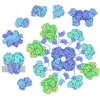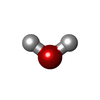+ Open data
Open data
- Basic information
Basic information
| Entry | Database: PDB / ID: 9dz8 | ||||||||||||||||||||||||||||||
|---|---|---|---|---|---|---|---|---|---|---|---|---|---|---|---|---|---|---|---|---|---|---|---|---|---|---|---|---|---|---|---|
| Title | Catalytic domain of Dihydrolipoamide Succinytransferase | ||||||||||||||||||||||||||||||
 Components Components | Dihydrolipoyllysine-residue succinyltransferase component of 2-oxoglutarate dehydrogenase complex | ||||||||||||||||||||||||||||||
 Keywords Keywords | TRANSFERASE / E2 / 2-oxoglutarate dehydrogenase complex / catalytic domain / tricarboxylic acid cycle | ||||||||||||||||||||||||||||||
| Function / homology |  Function and homology information Function and homology informationL-lysine catabolic process to acetyl-CoA via saccharopine / dihydrolipoyllysine-residue succinyltransferase / dihydrolipoyllysine-residue succinyltransferase activity / oxoglutarate dehydrogenase complex / tricarboxylic acid cycle / cytosol Similarity search - Function | ||||||||||||||||||||||||||||||
| Biological species |  | ||||||||||||||||||||||||||||||
| Method | ELECTRON MICROSCOPY / single particle reconstruction / cryo EM / Resolution: 2.51 Å | ||||||||||||||||||||||||||||||
 Authors Authors | Carr, K.D. / Borst, A.J. / Weidle, C. | ||||||||||||||||||||||||||||||
| Funding support |  United States, 1items United States, 1items
| ||||||||||||||||||||||||||||||
 Citation Citation |  Journal: J Struct Biol X / Year: 2025 Journal: J Struct Biol X / Year: 2025Title: Protein identification using Cryo-EM and artificial intelligence guides improved sample purification. Authors: Kenneth D Carr / Dane Evan D Zambrano / Connor Weidle / Alex Goodson / Helen E Eisenach / Harley Pyles / Alexis Courbet / Neil P King / Andrew J Borst /  Abstract: Protein purification is essential in protein biochemistry, structural biology, and protein design, enabling the determination of protein structures, the study of biological mechanisms, and the ...Protein purification is essential in protein biochemistry, structural biology, and protein design, enabling the determination of protein structures, the study of biological mechanisms, and the characterization of both natural and de novo designed proteins. However, standard purification strategies often encounter challenges, such as unintended co-purification of contaminants alongside the target protein. This issue is particularly problematic for self-assembling protein nanomaterials, where unexpected geometries may reflect novel assembly states, cross-contamination, or native proteins originating from the expression host. Here, we used an automated structure-to-sequence pipeline to first identify an unknown co-purifying protein found in several purified designed protein samples. By integrating cryo-electron microscopy (Cryo-EM), ModelAngelo's sequence-agnostic model-building, and Protein BLAST, we identified the contaminant as dihydrolipoamide succinyltransferase (DLST). This identification was validated through comparisons with DLST structures in the Protein Data Bank, AlphaFold 3 predictions based on the DLST sequence from our E. coli expression vector, and traditional biochemical methods. The identification informed subsequent modifications to our purification protocol, which successfully excluded DLST from future preparations. To explore the potential broader utility of this approach, we benchmarked four computational methods for DLST identification across varying resolution ranges. This study demonstrates the successful application of a structure-to-sequence protein identification workflow, integrating Cryo-EM, ModelAngelo, Protein BLAST, and AlphaFold 3 predictions, to identify and ultimately help guide the removal of DLST from sample purification efforts. It highlights the potential of combining Cryo-EM with AI-driven tools for accurate protein identification and addressing purification challenges across diverse contexts in protein science. | ||||||||||||||||||||||||||||||
| History |
|
- Structure visualization
Structure visualization
| Structure viewer | Molecule:  Molmil Molmil Jmol/JSmol Jmol/JSmol |
|---|
- Downloads & links
Downloads & links
- Download
Download
| PDBx/mmCIF format |  9dz8.cif.gz 9dz8.cif.gz | 2 MB | Display |  PDBx/mmCIF format PDBx/mmCIF format |
|---|---|---|---|---|
| PDB format |  pdb9dz8.ent.gz pdb9dz8.ent.gz | 1.7 MB | Display |  PDB format PDB format |
| PDBx/mmJSON format |  9dz8.json.gz 9dz8.json.gz | Tree view |  PDBx/mmJSON format PDBx/mmJSON format | |
| Others |  Other downloads Other downloads |
-Validation report
| Summary document |  9dz8_validation.pdf.gz 9dz8_validation.pdf.gz | 1.3 MB | Display |  wwPDB validaton report wwPDB validaton report |
|---|---|---|---|---|
| Full document |  9dz8_full_validation.pdf.gz 9dz8_full_validation.pdf.gz | 1.3 MB | Display | |
| Data in XML |  9dz8_validation.xml.gz 9dz8_validation.xml.gz | 149.5 KB | Display | |
| Data in CIF |  9dz8_validation.cif.gz 9dz8_validation.cif.gz | 188.5 KB | Display | |
| Arichive directory |  https://data.pdbj.org/pub/pdb/validation_reports/dz/9dz8 https://data.pdbj.org/pub/pdb/validation_reports/dz/9dz8 ftp://data.pdbj.org/pub/pdb/validation_reports/dz/9dz8 ftp://data.pdbj.org/pub/pdb/validation_reports/dz/9dz8 | HTTPS FTP |
-Related structure data
| Related structure data |  47326MC M: map data used to model this data C: citing same article ( |
|---|---|
| Similar structure data | Similarity search - Function & homology  F&H Search F&H Search |
- Links
Links
- Assembly
Assembly
| Deposited unit | 
|
|---|---|
| 1 |
|
- Components
Components
| #1: Protein | Mass: 26107.420 Da / Num. of mol.: 24 / Source method: isolated from a natural source / Source: (natural)  References: UniProt: A0A140NDX4, dihydrolipoyllysine-residue succinyltransferase #2: Water | ChemComp-HOH / | Has protein modification | N | |
|---|
-Experimental details
-Experiment
| Experiment | Method: ELECTRON MICROSCOPY |
|---|---|
| EM experiment | Aggregation state: PARTICLE / 3D reconstruction method: single particle reconstruction |
- Sample preparation
Sample preparation
| Component | Name: Dihydrolipoamide Succinyltransferase / Type: COMPLEX Details: This protein was observed as contaminant in a sample of a two component nanoparticle assembly. Entity ID: #1 / Source: NATURAL |
|---|---|
| Molecular weight | Value: 1.056 MDa / Experimental value: NO |
| Source (natural) | Organism:  |
| Buffer solution | pH: 8 |
| Specimen | Conc.: 0.3 mg/ml / Embedding applied: NO / Shadowing applied: NO / Staining applied: NO / Vitrification applied: YES Details: This sample was heterogeneous and contamined both DLST and the designed nanoparticle assembly. |
| Specimen support | Grid material: COPPER / Grid mesh size: 300 divisions/in. / Grid type: Quantifoil R2/2 |
| Vitrification | Instrument: FEI VITROBOT MARK IV / Cryogen name: ETHANE / Humidity: 100 % / Chamber temperature: 295.15 K Details: Wait time: 7.5 seconds Blot time: 0.5 seconds Blot force: 0 seconds |
- Electron microscopy imaging
Electron microscopy imaging
| Experimental equipment |  Model: Titan Krios / Image courtesy: FEI Company |
|---|---|
| Microscopy | Model: TFS KRIOS |
| Electron gun | Electron source:  FIELD EMISSION GUN / Accelerating voltage: 300 kV / Illumination mode: FLOOD BEAM FIELD EMISSION GUN / Accelerating voltage: 300 kV / Illumination mode: FLOOD BEAM |
| Electron lens | Mode: BRIGHT FIELD / Nominal defocus max: 1800 nm / Nominal defocus min: 800 nm / Cs: 2.7 mm |
| Image recording | Average exposure time: 5 sec. / Electron dose: 47 e/Å2 / Film or detector model: GATAN K3 BIOQUANTUM (6k x 4k) / Num. of grids imaged: 1 / Num. of real images: 4264 Details: 6211 movies were collected, the best 4264 were used for particle picking and further processing. |
| Image scans | Width: 5760 / Height: 4092 |
- Processing
Processing
| EM software |
| ||||||||||||||||||||||||||||||||||||||||||||||||
|---|---|---|---|---|---|---|---|---|---|---|---|---|---|---|---|---|---|---|---|---|---|---|---|---|---|---|---|---|---|---|---|---|---|---|---|---|---|---|---|---|---|---|---|---|---|---|---|---|---|
| CTF correction | Type: PHASE FLIPPING AND AMPLITUDE CORRECTION | ||||||||||||||||||||||||||||||||||||||||||||||||
| Symmetry | Point symmetry: O (octahedral) | ||||||||||||||||||||||||||||||||||||||||||||||||
| 3D reconstruction | Resolution: 2.51 Å / Resolution method: FSC 0.143 CUT-OFF / Num. of particles: 19033 / Num. of class averages: 76 / Symmetry type: POINT | ||||||||||||||||||||||||||||||||||||||||||||||||
| Atomic model building | B value: 69.9 / Protocol: OTHER / Space: REAL / Target criteria: Cross-correlation coefficient Details: The final model was built to density using the UniProt sequence in ModelAngelo. Further refinement of the model to the density was performed using ISOLDE in ChimeraX, Coot, Phenix. Waters ...Details: The final model was built to density using the UniProt sequence in ModelAngelo. Further refinement of the model to the density was performed using ISOLDE in ChimeraX, Coot, Phenix. Waters were built to one chain and then that chain and water network were rebuilt in ChimeraX using symmetry. | ||||||||||||||||||||||||||||||||||||||||||||||||
| Atomic model building | Details: ModelAngelo / Source name: Other / Type: in silico model |
 Movie
Movie Controller
Controller



 PDBj
PDBj


